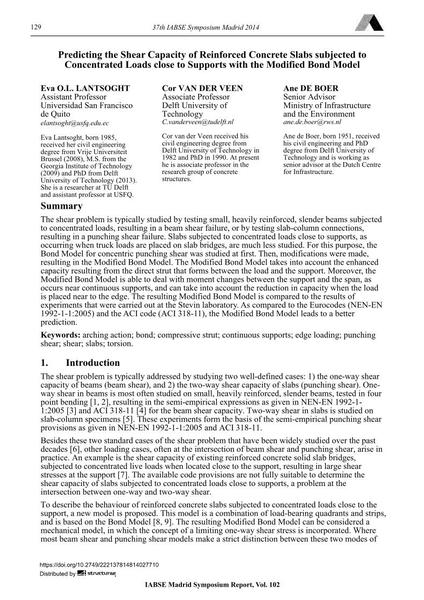Predicting the Shear Capacity of Reinforced Concrete Slabs subjected to Concentrated Loads close to Supports with the Modified Bond Model

|
|
|||||||||||
Bibliografische Angaben
| Autor(en): |
Eva O. L. Lantsoght
Cor van der Veen Ane de Boer |
||||
|---|---|---|---|---|---|
| Medium: | Tagungsbeitrag | ||||
| Sprache(n): | Englisch | ||||
| Tagung: | IABSE Symposium: Engineering for Progress, Nature and People, Madrid, Spain, 3-5 September 2014 | ||||
| Veröffentlicht in: | IABSE Symposium Madrid 2014 | ||||
|
|||||
| Seite(n): | 129-136 | ||||
| Anzahl der Seiten (im PDF): | 8 | ||||
| Jahr: | 2014 | ||||
| DOI: | 10.2749/222137814814027710 | ||||
| Abstrakt: |
The shear problem is typically studied by testing small, heavily reinforced, slender beams subjected to concentrated loads, resulting in a beam shear failure, or by testing slab-column connections, resulting in a punching shear failure. Slabs subjected to concentrated loads close to supports, as occurring when truck loads are placed on slab bridges, are much less studied. For this purpose, the Bond Model for concentric punching shear was studied at first. Then, modifications were made, resulting in the Modified Bond Model. The Modified Bond Model takes into account the enhanced capacity resulting from the direct strut that forms between the load and the support. Moreover, the Modified Bond Model is able to deal with moment changes between the support and the span, as occurs near continuous supports, and can take into account the reduction in capacity when the load is placed near to the edge. The resulting Modified Bond Model is compared to the results of experiments that were carried out at the Stevin laboratory. As compared to the Eurocodes (NEN-EN 1992-1-1:2005) and the ACI code (ACI 318-11), the Modified Bond Model leads to a better prediction. |
||||
| Stichwörter: |
Torsion Verdrehung Schub
|
||||
